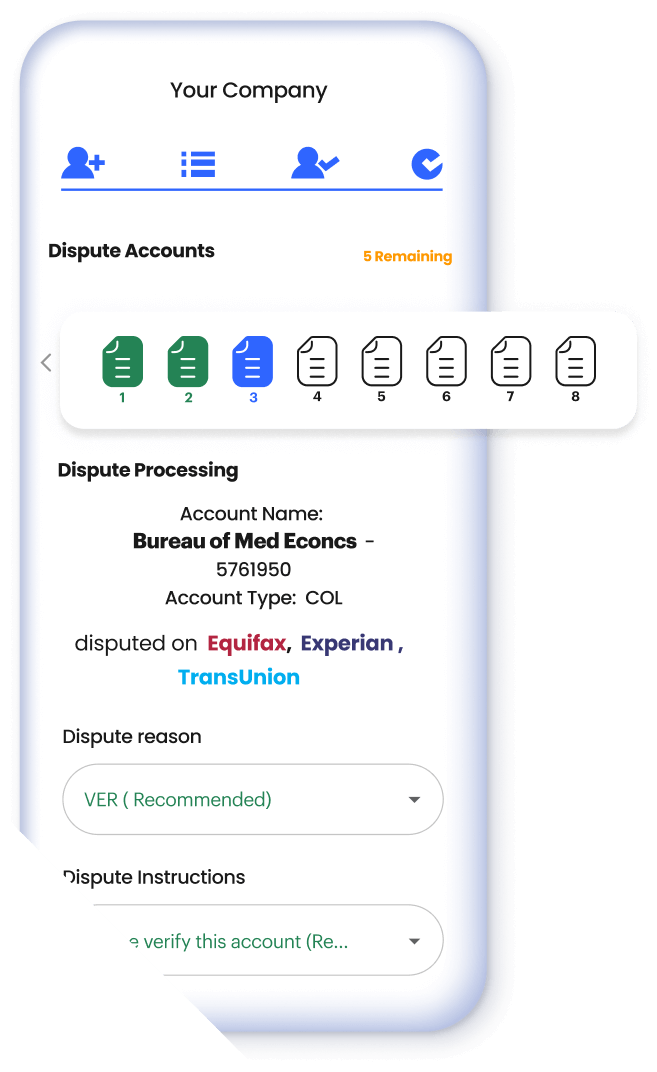In the world of financial management, maintaining a healthy credit score is paramount. However, repairing and improving credit can be a daunting and time-consuming process. Enter White Label Diy Credit Repair Software, a revolutionary tool designed to empower individuals with the ability to take control of their credit repair journey. This innovative software provides a user-friendly interface that guides users through the intricate process of repairing their credit. With its white label feature, individuals can also customize and brand the software as their own, enhancing their credibility and trustworthiness. Never before has credit repair been made so accessible and effortless.

This image is property of creditreportdiy.com.
What is White Label DIY Credit Repair Software?
White Label DIY Credit Repair Software refers to a comprehensive software solution that allows businesses to offer credit repair services to their clients under their own brand. This type of software provides a complete suite of tools and features necessary for individuals or businesses to manage the credit repair process independently. With White Label DIY Credit Repair Software, companies can customize the software’s branding and personalization to align with their own brand image and seamlessly integrate it into their existing operations.
Definition of White Label DIY Credit Repair Software
White Label refers to a product or service that is created by one company and then branded and sold by another company as their own. In the context of credit repair software, white label solutions allow businesses in the credit repair industry to offer their clients access to a feature-rich software platform under their own branding and without having to invest in developing their own technology from scratch. DIY, which stands for “Do It Yourself,” implies that users have the autonomy to manage the credit repair process independently using the software’s tools and features.
Purpose of White Label DIY Credit Repair Software
The purpose of White Label DIY Credit Repair Software is to enable credit repair businesses to provide their clients with a user-friendly and efficient platform to address and improve their credit profiles. By offering a self-service software solution, businesses can empower their customers to take control of their credit repair journey, ultimately enhancing their financial well-being. This software streamlines the credit repair process, enables businesses to deliver a more personalized customer experience, and increases revenue potential by expanding their service offering to encompass credit repair solutions.
Benefits of White Label DIY Credit Repair Software
White Label DIY Credit Repair Software offers several advantages for businesses in the credit repair industry. By utilizing this software, companies can leverage the following benefits:
Custom Branding and Personalization
One of the significant benefits of White Label DIY Credit Repair Software is the ability to customize the branding and personalization to align with the company’s unique identity. This allows businesses to establish a strong brand presence in the market and create a more cohesive experience for their clients. Customization options may include logo placement, color scheme, and even the software’s user interface.
Increased Revenue Potential
Implementing White Label DIY Credit Repair Software opens up opportunities for credit repair businesses to expand their service offering and generate additional revenue streams. By providing clients with a comprehensive platform to manage their credit repair, businesses can charge for access to the software or offer value-added services, such as credit monitoring or identity theft protection, for a fee. This diversification of revenue sources can significantly contribute to the financial success of the business.
Enhanced Customer Experience
White Label DIY Credit Repair Software enhances the overall customer experience by empowering clients to take an active role in their credit repair journey. With self-service tools and resources readily available, customers can track their progress, create and manage disputes, and access educational materials to improve their credit knowledge. This level of autonomy and control fosters a sense of empowerment and transparency, ultimately improving customer satisfaction and loyalty.
Streamlined Credit Repair Process
By utilizing White Label DIY Credit Repair Software, businesses can streamline the credit repair process, making it more efficient and time-effective. The software typically automates various aspects of credit repair, such as credit report analysis, dispute creation and management, and documentation. This automation reduces manual errors, ensures consistency in the process, and allows businesses to handle a higher volume of cases without compromising quality.
Cost Savings
Implementing White Label DIY Credit Repair Software can lead to significant cost savings for businesses in the credit repair industry. Instead of investing in building and maintaining their own proprietary software, companies can utilize a white label solution at a fraction of the cost. This eliminates the need for extensive software development resources, infrastructure maintenance, and ongoing updates. Additionally, the scalability of white label solutions allows businesses to pay for the software based on their usage, further optimizing cost efficiency.
Features of White Label DIY Credit Repair Software
White Label DIY Credit Repair Software typically includes a range of features designed to support the credit repair process and enhance the user experience. Some of the key features commonly found in these software solutions are:
Credit Report Analysis
White Label DIY Credit Repair Software provides a built-in credit report analysis feature, which allows users to assess and understand their current credit profiles. The software analyzes credit reports from major credit bureaus, identifying potential errors, discrepancies, or negative items that may be affecting the individual’s creditworthiness. This analysis serves as a foundational step in the credit repair process, providing users with actionable insights and a starting point for dispute generation.
Dispute Creation and Management
Dispute creation and management capabilities are essential components of White Label DIY Credit Repair Software. These features enable users to identify inaccurate or outdated information on their credit reports and generate formal disputes to challenge the validity of such items. Users can create dispute letters directly within the software, providing all necessary information and supporting documentation. The software assists in tracking the progress of disputes, ensuring timely follow-ups and resolution.
Automated Workflow
To maximize efficiency and minimize manual effort, White Label DIY Credit Repair Software often incorporates automated workflow capabilities. These workflows standardize and streamline the credit repair process, allowing users to follow a structured path from credit report analysis to dispute submission and resolution. Automated workflows help users stay organized and provide a clear roadmap to navigate their credit repair journey, ultimately saving time and improving overall productivity.
Credit Score Tracking
Another valuable feature of White Label DIY Credit Repair Software is credit score tracking. The software continuously monitors and tracks users’ credit scores, alerting them to any changes or updates. This feature allows users to gauge their progress throughout the credit repair process and provides valuable feedback on the effectiveness of their efforts. Additionally, credit score tracking helps users identify areas for improvement and make actionable adjustments to their credit habits.
Document Management
White Label DIY Credit Repair Software typically includes robust document management capabilities to streamline the storage, organization, and retrieval of important credit repair documents. Users can securely upload and store supporting documents, such as identification, proof of address, and evidence of disputed items. This centralized document management system ensures that all relevant information is readily accessible when needed, simplifying the credit repair process and enhancing efficiency.
Communication and Support
To facilitate effective communication and support, White Label DIY Credit Repair Software often features built-in communication tools. These tools allow users to communicate with their credit repair service provider or support agents directly within the software platform. Users can ask questions, seek clarification, and receive guidance throughout their credit repair journey. This real-time communication streamlines the process, eliminates the need for external communication channels, and enhances overall customer experience.
How White Label DIY Credit Repair Software Works
White Label DIY Credit Repair Software typically follows a structured process to guide users through their credit repair journey. The key steps involved in using this software are as follows:
Integrating with Credit Bureaus
Upon implementing White Label DIY Credit Repair Software, businesses need to integrate the software with major credit bureaus to access users’ credit reports. This integration enables the software to pull credit reports from the bureaus, ensuring accurate analysis and dispute generation.
User Registration and Onboarding
Users begin their credit repair journey by registering and creating an account within the White Label DIY Credit Repair Software. This process typically involves providing personal information, such as name, contact details, and social security number, to facilitate credit report access. Users may also have to agree to the software’s terms and conditions before gaining access to the platform.
Credit Report Import and Analysis
Once registered, users can import their credit reports to the software platform either manually or via automated synchronization with credit bureaus. The software then analyzes the imported credit reports, identifying potential errors, negative items, or inaccuracies that may be impacting the individual’s creditworthiness. This analysis provides users with an overview of their current credit situation and serves as a foundation for dispute generation.
Dispute Generation and Submission
Based on the identified errors and negative items, users can generate dispute letters directly within the White Label DIY Credit Repair Software. The software typically provides pre-populated dispute templates, allowing users to customize and tailor the content to their specific case. Users may also have the option to attach supporting documentation, such as receipts or statements, to strengthen their disputes. Once the dispute letters are complete, users can submit them electronically to credit bureaus or mailing addresses specified by the bureaus.
Communication and Reporting
Throughout the credit repair process, White Label DIY Credit Repair Software enables users to maintain communication with their credit repair service provider or support team. Users can initiate communication directly within the software platform, seeking assistance, clarification, or updates on their case. The software also generates reports on the status of disputes, enabling users to track progress, identify successful resolutions, and make informed decisions about their credit repair strategies.

This image is property of i.etsystatic.com.
Choosing the Right White Label DIY Credit Repair Software
Choosing the right White Label DIY Credit Repair Software is crucial for businesses in the credit repair industry. Considerations for selecting the most suitable software solution include:
Features and Functionality
When evaluating White Label DIY Credit Repair Software options, businesses should carefully assess the features and functionalities offered by each solution. It is essential to ensure that the software includes the necessary features to meet the business’s unique requirements. Key features to look for may include credit report analysis, dispute creation and management, automated workflows, credit score tracking, and document management capabilities.
Scalability and Customization
Businesses should consider the scalability and customization options provided by White Label DIY Credit Repair Software. As the business grows and evolves, the software should be able to accommodate increased usage and adapt to changing needs. Additionally, the software should offer extensive customization capabilities, allowing businesses to align the software’s branding and user experience with their unique brand identity.
Security and Compliance
Given the sensitivity of personal and financial information involved in credit repair, security and compliance should be a top priority when selecting White Label DIY Credit Repair Software. Businesses must ensure that the software adheres to industry-standard data security measures, such as encryption and secure data storage. Moreover, the software should comply with relevant regulations, such as the Fair Credit Reporting Act (FCRA), to ensure legal compliance and protect users’ privacy.
User-Friendly Interface
A user-friendly interface is crucial for White Label DIY Credit Repair Software, as it directly impacts user adoption and satisfaction. Businesses should choose software solutions that offer an intuitive and easy-to-navigate interface, minimizing the learning curve for users. A well-designed interface improves usability, reduces errors, and enhances overall user experience, leading to higher customer satisfaction rates.
Pricing and Integration Options
The cost of White Label DIY Credit Repair Software and its integration options should also be taken into consideration. Businesses should evaluate the pricing models offered by different software providers, ensuring that the pricing is competitive and aligns with the business’s budget. Additionally, businesses should assess the ease of integrating the software with their existing systems, such as customer relationship management (CRM) software or payment gateways, to ensure a seamless workflow.
White Label DIY Credit Repair Software vs. Outsourced Credit Repair Services
When deciding between White Label DIY Credit Repair Software and outsourced credit repair services, businesses must weigh the advantages and disadvantages of each option.
Advantages of White Label DIY Credit Repair Software
White Label DIY Credit Repair Software offers businesses greater control and autonomy over the credit repair process. By providing clients with self-service software, businesses can empower clients to take an active role in their credit repair journey, leading to a more personalized experience. Additionally, implementing White Label DIY Credit Repair Software allows businesses to expand their service offering, increase revenue potential, and reduce costs by eliminating the need for extensive manual labor.
Advantages of Outsourced Credit Repair Services
Outsourced credit repair services, on the other hand, offer businesses the convenience of having professionals handle the credit repair process on their behalf. This allows businesses to focus on their core operations without investing significant time and resources in managing the credit repair process. Additionally, outsourced services may provide expertise and industry knowledge that businesses may not possess, potentially leading to more effective credit repair outcomes.
Making the Best Choice for Your Business
The choice between White Label DIY Credit Repair Software and outsourced credit repair services depends on various factors, including the business’s resources, expertise, and strategic goals. By carefully evaluating these factors and considering the advantages and disadvantages of each option, businesses can make an informed decision that aligns with their unique needs and objectives.

This image is property of creditreportdiy.com.
Top White Label DIY Credit Repair Software Providers
Several software providers specialize in offering White Label DIY Credit Repair Software. The following are some prominent providers in the market:
Provider 1
Provider 1 offers a comprehensive White Label DIY Credit Repair Software solution designed to empower businesses in the credit repair industry. Their software includes advanced features such as intelligent credit report analysis, automated dispute generation, and secure document management. Provider 1 also offers extensive customization options, allowing businesses to align the software with their brand identity and seamlessly integrate it into their existing operations.
Provider 2
Provider 2 provides a user-friendly White Label DIY Credit Repair Software solution, catering to businesses of all sizes. Their software includes robust credit report analysis capabilities, automated workflows, and credit score tracking features. Provider 2 also offers a range of integration options, allowing businesses to connect their software with existing tools and systems for a streamlined workflow.
Provider 3
Provider 3 is a reputable provider of White Label DIY Credit Repair Software, offering a comprehensive suite of features to support the credit repair process. Their software includes intuitive dispute creation and management tools, communication and support features, and real-time reporting capabilities. Provider 3 also prioritizes data security and compliance, ensuring the confidentiality and privacy of users’ information.
Provider 4
Provider 4 specializes in scalable and customizable White Label DIY Credit Repair Software solutions, tailored to meet the unique needs of credit repair businesses. Their software includes advanced credit report analysis features, automated workflows, and document management capabilities. Provider 4 also offers flexible pricing options to accommodate businesses of all sizes and budgets.
Provider 5
Provider 5 is a trusted provider of White Label DIY Credit Repair Software, delivering a user-friendly platform with comprehensive functionality. Their software includes features such as dispute generation and tracking, credit score monitoring, and secure document storage. Provider 5 also offers extensive customer support, ensuring businesses receive the assistance they need to successfully implement and utilize the software.
Key Considerations for Implementing White Label DIY Credit Repair Software
Implementing White Label DIY Credit Repair Software requires careful planning and consideration. Some key considerations for a successful implementation include:
Training and Support
Ensuring that the necessary training and support resources are available to users is vital for a successful implementation. Businesses should provide comprehensive training materials, including user guides and video tutorials, to help clients navigate the software effectively. Additionally, having a dedicated support team available to address users’ inquiries, troubleshoot issues, and offer guidance throughout the credit repair process is crucial.
Integration with Existing Systems
Businesses should evaluate the compatibility and integration capabilities of White Label DIY Credit Repair Software with their existing systems. Seamless integration with tools such as CRM software, payment gateways, or customer support platforms can significantly improve operational efficiency and streamline the credit repair process. The software provider should offer robust integration options and provide support during the integration process.
Data Security and Privacy Measures
Protecting users’ personal and financial information is of utmost importance when implementing White Label DIY Credit Repair Software. Businesses should ensure that the software provider adheres to industry-standard data security measures, such as encryption, secure data storage, and regular security audits. Additionally, compliance with relevant regulations, such as the FCRA, should be carefully assessed to maintain legal compliance and protect users’ privacy.
Marketing and Promotional Strategies
To maximize the benefits of White Label DIY Credit Repair Software, businesses should develop effective marketing and promotional strategies. This includes raising awareness of the software’s availability, highlighting its benefits, and showcasing success stories or testimonials from satisfied clients. Implementing marketing initiatives, such as social media campaigns, targeted advertisements, and partnerships with relevant industry influencers, can help drive adoption and generate new leads for the business.

This image is property of i.etsystatic.com.
Best Practices for Success with White Label DIY Credit Repair Software
To achieve success with White Label DIY Credit Repair Software, businesses should consider implementing the following best practices:
Establishing a Clear Process
Before launching the software, it is crucial to establish a clear and standardized credit repair process. This includes defining the steps involved, documenting standard operating procedures, and creating templates for dispute letters or other required documents. A well-defined process ensures consistency, minimizes errors, and improves efficiency throughout the credit repair journey.
Efficient Workflow Management
Utilizing the automated workflow capabilities of White Label DIY Credit Repair Software can significantly enhance efficiency and productivity. Businesses should take full advantage of these features by ensuring users follow a structured path, setting clear milestones, and leveraging automated reminders and notifications. Regularly reviewing and optimizing workflows to eliminate bottlenecks or redundant steps is also essential for continuous improvement.
Regular Monitoring and Reporting
Monitoring and tracking the progress of credit repair cases is crucial for success. White Label DIY Credit Repair Software typically provides real-time reporting features that allow businesses to monitor the status of disputes, track improvements in clients’ credit profiles, and identify areas for improvement. Regularly reviewing these reports and analyzing the data helps businesses make informed decisions, assess the effectiveness of their strategies, and adapt their approach as needed.
Customer Education and Engagement
Providing clients with comprehensive education and resources is key to their success in using White Label DIY Credit Repair Software. Businesses should develop educational materials, such as guides, videos, or webinars, to help clients understand the credit repair process and make informed decisions. Additionally, actively engaging with clients by offering regular updates, answering their questions promptly, and providing personalized support ensures a positive customer experience and increases the likelihood of successful credit repair outcomes.
Conclusion
White Label DIY Credit Repair Software offers a powerful solution for businesses in the credit repair industry to provide their clients with effective credit repair services under their own branding. By implementing this software, businesses can leverage its benefits, such as custom branding, increased revenue potential, enhanced customer experience, streamlined credit repair process, and cost savings. Carefully evaluating the features, scalability, security, and user-friendliness of available software options is crucial when choosing the right solution. By following best practices, such as establishing clear processes, efficient workflow management, regular monitoring, and customer education, businesses can maximize the potential of White Label DIY Credit Repair Software and contribute to the financial well-being of their clients.
Summary of Benefits
White Label DIY Credit Repair Software provides numerous benefits for businesses in the credit repair industry. These benefits include the ability to customize branding, increased revenue potential, enhanced customer experience, streamlined credit repair process, and cost savings.
Future Trends of White Label DIY Credit Repair Software
As technology continues to evolve, the future of White Label DIY Credit Repair Software is likely to see advancements in areas such as artificial intelligence (AI) and machine learning (ML). These technologies may enable automation of more complex credit repair processes, improve accuracy in credit report analysis, and provide users with predictive insights for optimizing their credit profiles. Additionally, increased integration capabilities with other financial management tools and services may further enhance the user experience and efficiency of the credit repair process.

This image is property of i.pinimg.com.
